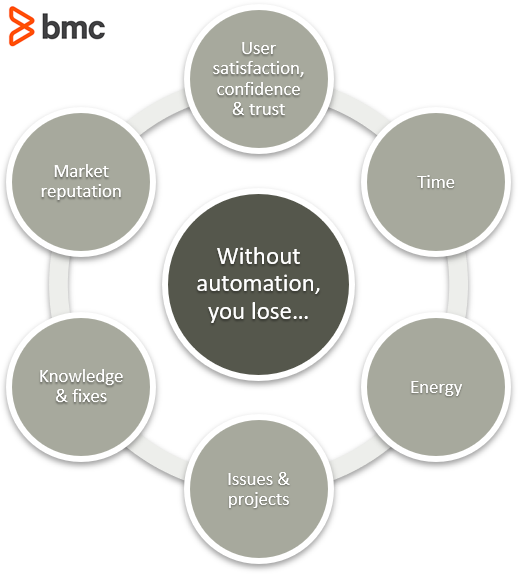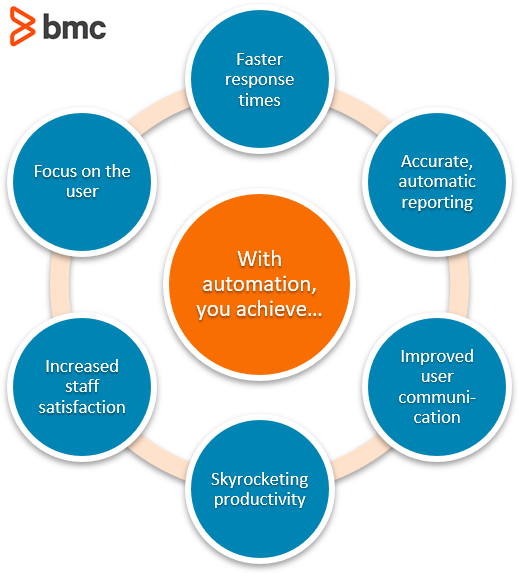If your help desk is not employing every possible option for automation that’s available, you are missing out on opportunities to:
- Improve productivity
- Increase customer satisfaction
With readily accessible tools to automate common, repeatable tasks undertaken by the help desk, I find myself shaking my head when I see so many—particularly in small to medium businesses—that have still not taken advantage of available technology solutions.
Here, I’ll introduce you to help desk automation, from why and how start to building your investment case to how to choose automation tools.
Your help desk’s current state
Do you still manually reset passwords and unlock accounts? Do you spend time assigning access rights to folders and applications? Do you manually assign and prioritise incidents and service requests?
If you do, I have one question: Why?

Automating these tasks removes the drudgery from your help desk analysts and allows them to spend more time resolved more complex queries, meaning they can get customers back to work faster as well as giving them far better job satisfaction. Nobody wants to spend their days clicking on ‘unlock account’ buttons and listening to customers explain why they have forgotten their password for the fifth time this year.
Why do organizations—of all sizes—continue to use manual processes on their help desks?
The answer you will often get is that these tools are expensive, and they cannot justify the investment. Unfortunately for them, that is not a valid argument. The outlay required to automate basic tasks has a rapid return on investment (ROI).
Every day that your help desk depends on manual workflows, you risk losing:
- User satisfaction, confidence, trust
- Time that could be spent on direct assistance, not admin drudgery
- Energy that could be directed toward learning and skills improvement
- Issues and projects that fall through the cracks
- Knowledge and fixes that are not shared with the team
- Market reputation
Ultimately, all these inefficiencies cost your company money and your well-earned reputation.
Prioritize automation
If you want to improve the value your help desk offers to the business, then automation needs to be at the top of your ‘to do’ list. Why? It will allow you to:
- Use your team’s skills more effectively
- Get a grip on heavy or spiking workloads
- Accelerate issue resolution to please users
- Look like a help desk hero to management
Automation can help your team stay lean while handling larger volumes of tickets with ease. In other words, automation helps you work smarter, not harder.
Benefits of help desk automation to build your case
There are many benefits from employing automation on your help desk. These five benefits, however, stand out for their clarity in convincing top leadership that you need to prioritize automation on the help desk—ASAP.

1. Faster response times
Help desk teams are judged by how quickly they respond to and resolve issues. Being able to quickly resolve issues will greatly improve customer satisfaction.
Workflow automation and orchestration can significantly improve incident response times and problem resolution by incorporating predetermined if, then capabilities. In other words, if you receive a request like this, then do this specific task. For instance, if the help desk receives a call about a printer problem, workflow automation can:
- Determine the type of call.
- Route it to the right person.
- Send an automated response to the user.
Most automation systems also provide some way of allowing users to submit their own tickets via a web portal or email, thus reducing calls to the help desk while speeding up routing—a two for one benefit.
2. More accurate reporting
Automating workflows improves the accuracy of help desk statistics by avoiding human errors and inconsistencies in data entry. It also relieves managers of the manual work required to collect data and correct errors. Field defaults, required fields, and auto-routing rules are all tools to ensure every incident reported is handled properly and in precisely the same way.
Understanding how your help desk is currently performing will give you the information you need to plan improvements.
3. Improved user communication
One thing that annoys customers, perhaps more than anything else, is a lack of communication. When help desk analysts are busy trying to resolve incidents or fulfil service requests, it is easy to neglect customer communication.
Automating standard customer communications will mean that you can keep customers informed with little or no effort required from support staff. Automating call notifications, SLA escalations, and call resolution emails will:
- Ensure that your customers understand what is happening with their calls
- Help to manage their expectations
4. Skyrocketing productivity
When you can resolve incidents faster and fulfill requests more efficiently, users get back to work faster. This increases productivity and ultimately improves the bottom line for the business.
5. Increased staff satisfaction
Automation of mundane, repeated tasks frees up help desk team members to concentrate on more challenging work. This will increase their job satisfaction and motivation, reducing the cost of higher turnover.
Choosing help desk automation solutions
Help desk software solutions offer powerful help desk automation functionality based on customizable business rules. When it comes to automation in help desk software, make sure you’re getting these capabilities:
- Automatically capturing and logging all incoming requests
- Automatically assigning each issue to a specific help desk technician (or group of technicians) based on skill routing
- Automatically notifying the technician that a new task has been assigned
- Automatically prioritizing issues according to rules (i.e. severity, system, person reporting)
- Automatically applying due dates and routing based on configurable service level agreements (SLAs)
- Providing tools to document successful fixes for issues so they can be leveraged later
- Creating and automating workflows to deal with processes such as user onboarding
- Documenting communication with the user
- Automatically notifying users of issue resolution or escalation
- Automatically surveying users after their issue is resolved to gauge satisfaction levels
- Generating reports based on issue-related and service-related metrics and automatically sending these to stakeholders
Additional automation will allow you to process simple requests without any human intervention, such as:
- Password resets
- Folder creation
- Permissions
No question on automation
If you can automate, you should automate. Initial investment for technology solutions to facilitate automation will quickly be returned by way of improved efficiencies, reduction in errors, increased business productivity, and higher levels of customer satisfaction.
Additional resources
For more on this topic, explore these resources:
- BMC Service Management Blog
- Service Desk Automation: Are You Missing Opportunities?
- 7 Ways to Put Automation Everywhere Into Practice for the Enterprise
- What are Service Orchestration and Automation Platforms (SOAPs)?
- 5 Metrics & KPIs All Service Desks Need
- SLA Best Practices for ITIL, Help Desk & Service Desk
The Autonomous Digital Enterprise - Automation Everywhere
These postings are my own and do not necessarily represent BMC's position, strategies, or opinion.
See an error or have a suggestion? Please let us know by emailing blogs@bmc.com.






